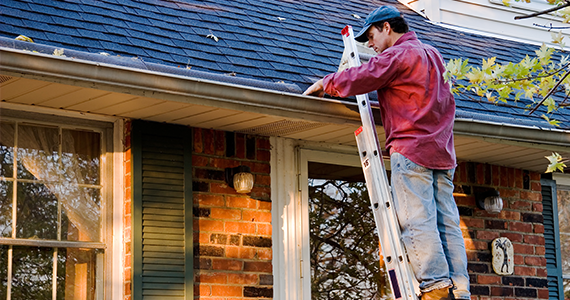Win the War of The Falling Leaves with Gutter Guards
Before autumn begins it’s relentless assault on your home with a barrage of gutter-clogging leaves, have gutter guards installed and win the battle!
Gutter guards are exactly what you think. They’re devices installed in or on your gutters to protect them against leaves, sticks, and other debris that can clog them, leading to damaging leaks, overflow, ice dams, sagging and other damage requiring costly repairs. Their success generally depends on the types of trees you have on your property and the proximity of those trees to your roof. If you have trees close to your house that shed small needles, for example, guards with larger holes probably wouldn’t work well for your gutters.
Perforated Aluminum Guards
These are sheets of aluminum with holes punched in them that let water through and keep leaves out. They sit flat in the gutter. They work well with leaves but not so much with pine needles and oak trees that shed “tassels” in the spring.
Solid Gutter Covers
This type of guard goes above the gutter and has an edge with a reverse curve that, as water flows into the gutter, any leaves or debris falls to the ground. They work very well for homes where trees don’t hang over the roof and work best for trees that are not oak trees or pine trees. Those “tassels” and pine needles tend to stick to the surface area of the water and clog the gutter opening instead of falling off. Once the gutter is clogged, the water will flow over the gutter guard and directly onto the siding or the ground. Solid guards are installed under your roof shingles which means if you don’t like them, you’ll have to have them professionally removed.
Micromesh Gutter Guards
Michromesh guards use a fine, stainless steel mesh that is installed on top of the gutter. The screens keep out even small material like pine needles from clogging the gutters. Some worry that the small holes restrict the flow of water and cause the gutters to overflow but there is little evidence of this happening. The micromesh is connected to a frame of PVC or aluminum. The aluminum framework is recommended as PVC can expand and contract during periods of extreme heat or extreme cold.
Foam Guards
Foam guards are long foam inserts that are set inside the gutter itself. They allow water and keep debris out. They are inexpensive and easy to install―it’s simply a matter of cutting them to the right length and setting them in the gutter. You really only have to call a professional if you don’t want to climb that ladder yourself. The main downside of foam gutters is that the foam material tends to deteriorate relatively quickly in the harsh elements.
Brush Guards
Brush guards are a similar to their foam counterparts. Long tubes of brushes that look like bottle brushes are placed in the gutter and allow water in. Unfortunately, debris tends to stick to the bristles, causing them to clog easily. Sometimes the cheaper option isn’t the best option.
Having gutter guards isn’t a guarantee that you’ll never need to have your gutters cleaned again. Even micromesh guards allow pollen and silt to get through and build up but obviously, gutter guards will cut down on the frequency in which you need to have it done. For solid guards, gutter cleaning means removing the guards because they’re installed under your shingles, so cleanings are more labor-intensive and costly. Mesh and perforated guards are easier to remove for cleaning.
While you can install gutter guards yourself, why risk life and limb climbing up on your rickety ladder? Why not have the professionals at Gutterpros join your battle against leaf build-up? Our highly-trained technicians will have your guards professionally installed quicker than you can say, “Viva la leaf résistance!” Call Gutterpros today at (314) 656-7195 and we’ll fight the good fight together!

